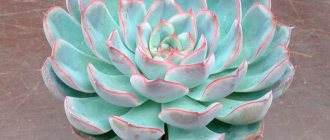Ficus is a popular indoor flower. First of all, this plant is valued for its decorative qualities. Having one or several ficus trees, a gardener can create a picturesque green corner at home. More than 500 species of ficus are known, all of them differ from each other. At home, ficus benjamina or large-leaved ficus is most often grown. House ficus is easy to propagate. Read our article about how to propagate ficus at home.
Optimal timing of the procedure 2. How to prepare for propagation of ficus 3. Propagation by leaves 4. Propagation by cuttings 5. Propagation by shoots 6. Care of a young plant
Photo by ru.depositphotos: The plant can be propagated in different ways, including by leaf.
Ficus propagation by leaf in 5 steps
Large-leaved ficus can easily be propagated by leaves:
- It is advisable to take a leaf from an old woody shoot.
- We cut the sheet at an angle of 45 degrees, retreating from the base of the sheet by about 5 cm.
- We treat the cut in a root formation stimulator and place it in water. If the leaf is very large, then you can cut off part of the leaf, but not more than half. Reducing the leaf blade will speed up the rooting process, since the plant will not waste energy on maintaining life in the leaf and will direct it to root formation.
- After 2–3 weeks, the first roots will appear. Throughout this period, you need to add fresh water and monitor the condition of the leaf.
- We plant the leaf with roots in the substrate and cover it with a plastic bag without tying it.
| Important! Ficus Benjamina does not reproduce by leaves. |
Photo pexels/Skylar Kang: Only large-leaved ficus is propagated by leaves.
Growing conditions
Evergreen indoor plants, which include ficus, need good lighting so that the leaves do not fall off and the crown grows quickly. In summer, you need to frequently bathe the plant to remove dust, as it delays the sun's rays and the synthesis of chlorophyll.
Watering twice a week in sunny weather is a prerequisite for continuous crop growth. Since it is a tropical plant, it needs to maintain indoor humidity so that the top leaves can absorb water from the air.
The most commonly grown in apartments is Benjamin's ficus with small leaves and a spreading crown, as well as large-leaved rubber-bearing ficus. In appearance these are two different plants. Reproduction at home of rubber-bearing ficus and Benjamin has common features, but you need to know in detail how the process of rooting young cuttings occurs.
How to propagate ficus from cuttings: important tips for growing healthy plants
Both ficus benjamina and large-leaved are successfully propagated by cuttings. This is the easiest and most affordable way to propagate ficus. It can be propagated by apical shoots or stem cuttings. Ficus benjamina is most easily propagated by last year's shoots that have not yet grown old. You can cut it at an angle of 45 degrees, or you can tear it off with the heel. Large-leaved ficus takes root best with older, lignified shoots.
Ficus propagation by apical shoots
The top of the shoot with 2–3 leaves is cut off. The optimal length of the cutting is 12–15 cm. You need to cut the cutting of the plant with a sharp, disinfected tool. This can be ordinary scissors, pruning shears, a knife, or a blade. The cut area on the mother plant must be powdered with crushed charcoal.
Before propagating Ficus Benjamin, you need to remove the milky sap from its cuttings. This can be done by holding the cutting under running warm water or placing the cutting in water. The cut stalk is slightly dried. Vermiculite is poured into a plastic cup with drainage holes, not reaching the top edge of the cup 2-3 cm. Water it generously with warm, settled water. Next, follow the recommendations:
- We dust the lower cut of the cutting in “Kornevin” or any other root formation stimulator.
- We bury the cuttings in vermiculite by about 2–3 cm.
- We place the glass in a transparent plastic bag, which we tie, creating greenhouse conditions.
- Place the cutting in a bright and warm place where it will not be exposed to direct sunlight.
- We periodically look into the bag, remove drops of condensation from the bag and, if necessary, moisten the vermiculite.
- The transparent sides of the cup make it easy to see when roots appear. As soon as the roots grow more than 2 cm, you can transplant the cuttings into the ground. Since the cutting was in greenhouse conditions for a long time, it got used to them. And if we immediately change the conditions of detention, without accustoming the young plant to the dry air in the room, then the cutting may “get sick,” freeze in growth, or even die. Therefore, after transplanting, we cover the ficus with a bag on top without tying it. Just throwing it on top. You need to keep it like this for three days. And only then can you completely remove the bag.
| Remember! The plant must be gradually accustomed to new conditions. This is an important condition when propagating ficus by cuttings. |
- In the substrate we make a recess for the cutting in the center of the container. This can be done with your finger or a stick. Carefully place the cutting there, trying not to damage the roots, and cover it with soil. Lightly press with your fingers so that the cutting “sits” confidently and does not fall over. When transplanting a vermiculite cutting into a special substrate, you can bury it slightly into the soil.
Photo by ru.detositphotos: Sections of cuttings must first be powdered in a root formation stimulator.
Features of propagation of home ficus by stem cuttings
For these purposes, the lateral or lower shoots of the plant are taken. It is best to take lignified branches from large-leaved ficus. Otherwise, rooting may not occur. Using a sharp tool, we cut the cuttings so that each has 2-3 buds. We make the lower cut at an angle of 45 degrees, and the upper one - straight. Next, we root either using the method described above, or the following (in cotton wool):
- Lightly dry the cuttings.
- Place a layer of wet cotton wool into the container. We place the lower cut of the cutting into this cotton wool, having previously dusted it in a root formation stimulator.
- We periodically moisten the cotton wool and wait for the roots to appear.
- When the roots appear, without waiting for long roots, we plant them in the ground.
| Important! The method of rooting in cotton wool is also suitable for apical shoots. |
During the rooting period, the grower must create the most optimal conditions for the growth of the plant - not over-watering, but also not over-drying. You need to water in small portions as the rooting material dries.
To propagate large-leaved ficus, you can immediately root the cuttings in the soil. To do this, you need to take a very loose and nutritious substrate. And we do everything else in the same way as with vermiculite.
Preparation for the procedure
Before starting the procedure, regardless of how it is performed, you should prepare everything you need :
- To begin with, you should select in advance a special place where this process will be carried out, prepare the necessary tools, a pot and everything that the plant may need.
- Depending on the method, you may need scissors or a sharpened knife; you can use a stationery knife or a regular one with a sharpened blade.
Attention! Under no circumstances should you use a blunt instrument, which could injure the plant or cause the death of the seedling. - You will need to prepare special dishes for transplanting and germination, soil with the necessary mixtures and drainage.
- If side shoots are needed for propagation, you can influence their growth in advance by pruning them correctly. Usually, in this case, the top of the plant is cut off, stimulating growth on the sides. We prepare a place where the seedling can take root. A window sill is not suitable for this, as direct rays will be detrimental to shoots. Ficus loves shade; the optimal place for germination will be the shaded part of the room.
- You need to take care of the temperature in advance. The plant needs warmth; if the temperature in the room is not high enough, it would be better to make a small greenhouse, otherwise, due to the low temperature, the seedlings will develop too slowly and will not give the desired result.
- We choose the right time of year for propagation, ficus hibernates in winter, spring or summer are considered the best seasons, the plant cannot be propagated in winter.
How to propagate ficus by shoots (air layering)
Sometimes large-leaved ficus is easiest to propagate by air layering. Especially if the plant is old. This method is not easy and is recommended only for experienced gardeners:
- On a thick branch we find a point where the branch will not bend much. Otherwise it will simply break. Remove the sheet and make a vertical cut.
- To ensure that the cut is always slightly open, we place a match in it. Then we wrap a small amount of moss around the cut and secure it with threads and film, leaving holes for air circulation.
- Next, we take care of the ficus as usual for 3-4 weeks. We periodically check the location of the incision. When the moss has grown roots, remove the film, cut off the cuttings and plant it in a separate pot.
Ficus benjamina can also be propagated by layering, in which the stem has become woody. Most often, old ficus trees are propagated this way. But the technology is slightly different from the one described above.
Indoor ficus - a flower of family well-being
Large green ficus leaves perfectly purify the air at home
Ficus is one of the first plants domesticated by humans. Biological scientists believe that it is an excellent air purifier. Indeed, in addition to the absorption of carbon dioxide and the release of oxygen into the air, which is characteristic of all plants, ficus destroys harmful substances such as phenol, formaldehyde and benzene. Scientists have also recorded cases of pathogenic bacteria being absorbed by the leaves of this plant.
In addition to the scientifically proven benefits of ficus, there are many folk signs associated with this flower. Believes that it suppresses a person’s negative emotions. In a bedroom with ficus, the owners have fewer nightmares and problems with insomnia are solved.
Esotericists claim that ficus protects the house from the evil eye and ill-wishers. To protect yourself from the evil intentions of strangers, you just need to place a pot with a plant in the corridor above the doorway. Because of these properties, ficus is often called the flower of family well-being.
Two tips for caring for young ficus
Follow the care recommendations to grow a full-fledged ficus:
- Watering a young ficus. After transplanting the cuttings into a pot with a substrate, you need to water it only with warm and settled water. Rain or snow water is perfect. Water the ficus moderately - only after the top layer of the substrate has dried.
- Feeding . The first feeding after planting the cuttings in the ground can be done after 3 months. You can use any universal fertilizer or a special one “for decorative deciduous trees.”
Photo by ru.depositphotos: Water the plant with warm water. ______________________________________________________________________________________________ Read our other articles about indoor flowers: Calendar for planting and replanting flowers for the year 8 reasons why ficus turns yellow and what to do for the health of your indoor flower
Propagation of chrysanthemums by cuttings: useful tips for propagating garden and indoor flowers How to grow Decembrist at home: tips for planting, caring for and propagating succulents ________________________________________________________________________________________________ What rules do you follow when propagating ficus? Share your experiences and tips with other gardeners in the comments.
Transplantation into the ground
After 25-40 days, when white roots 5 mm long appear at the base of the cuttings, young ficus trees can be safely planted in an earthen substrate. Instead of deep pots, it is better to use disposable glasses at first. In them, it will be easier for the root system to master the space and grow stronger, without spending a lot of energy on excessive growth.
24e5dcc43b763b49.jpg
Since these plants do not like excessive moisture, even small containers should have at least a thin drainage layer and a drainage hole. Instead of spongy expanded clay, which will absorb water, holding it at the base, it is advisable to give preference to ordinary small stones, broken bricks or pebbles.
The soil suitable for ficus is light and loose, well-permeable to air, with a neutral acidity level (5.5 - 6 pH). You can prepare it yourself from peat, turf/leaf soil and humus, in approximately equal proportions. To improve the structure, it will be useful to add a little river sand or vermiculite.
pic566_4628.jpeg
It is recommended to dip the roots extracted from the water into Kornevin powder or another growth stimulant - this way the chances of successful development of seedlings will be even higher. After this, they must be buried in a previously made hole, carefully sprinkled with soil, compacted a little on top and watered with warm water. Immediately after transplantation, young plants should remain in the greenhouse for another 2-4 weeks, with gradual ventilation and adaptation to the environment.
2356773.jpg
Watering and temperature conditions
In order for the life cycle of the ficus to be maximum, and for the flower to avoid possible diseases, it is necessary to maintain the atmosphere and humidity in the house at a certain level.
Watering
In summer, water the plant more often than in winter.
The main task when caring for a ficus is maintaining the correct soil moisture. Water for irrigation must be taken at room temperature. It is not recommended to take dirty or cold liquid.
In summer, watering ficus should be more often than in winter. But at the same time, it is necessary to ensure that the soil is not watery.
You can water your ficus no more than 3 times a week. And with the onset of cold weather, the volume of watering should be reduced so that in winter one watering is carried out per week. Don’t also forget to spray and wipe the leaves of the plant.
Temperature
Since ficus is a tropical plant, it is not surprising that this flower does not like drafts, soil hypothermia and low temperatures. Therefore, the place for the pot should be chosen away from the floor, windows and doors. A special flower shelf in a place inaccessible to drafts is perfect.
The best temperature for ficus in summer is from +25 to +28°C. In winter, this indicator should be from +16 to +18°C.
The minimum temperature threshold is +10 - +12°C. Temperatures that drop below this limit threaten the plant with dropping leaves and freezing.











